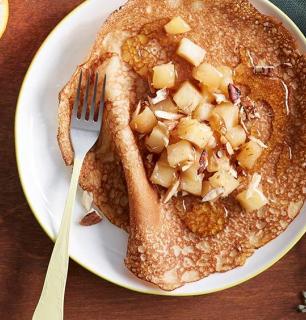Wheat harvest happiness
The wheat harvest is a far cry from being a simple flick of the sickle in September. It’s precision science, entirely dedicated to the baker’s passion that awakens to rise in January and that closes one eye – maybe – for a few days in December…
At the time of colonization, wheat farming made up close to three quarters of the grain harvests in Quebec. And then… nothing, niente, nada! The entire production migrated towards the Prairies for various reasons, good and bad, one of which was climate. But for the past three or four decades, wheat has once again flourished here in fleur-de-lys territory. And better than before with many different varieties. But this didn’t happen on its own by accident.
“If the wheat doesn’t come to you, you go to the wheat.” That could be the very motto of Bernard Fiset, tenacious baker and inspired co-founder of Première Moisson, who for years has been stubbornly trying to improve the image of local grains in an effort to honour the memory of bread.
He and Robert Beauchemin, a dedicated miller to whom Bernard attributes all the merits of their grain-related successes, recounted some highlights of their exploits fuelled by determination and real passions, both for the sake of the raw material and the kneader.
BREAD, AN INSIDE VIEW
“I had the opportunity to learn how to bake with my French father-in-law, a wonderful old stubborn guy, perfectly recalcitrant when faced with industrialized flours,” said Bernard. “When we started up the bakery, I wanted to make bread ‘like it used to be,’ but the flours I was dreaming of didn’t exist. I wanted to work with wheats from Quebec, cultivars low in protein, selected for their taste-related qualities and their aromas. The wheats I found were planted based on their compliance with the fields and their production.
“I had to convince an industrial miller to sell me flour that was unbleached, unprocessed and free of additives. When I approached him, he told me that I could never make bread with that! It took time, but I got it. I wanted to reduce the proteins even further. Proteins are friends of the industrials, not of the artisans. I didn’t obtain anything more.
“Then I met Michel Montignac. His approach to bread making was nothing short of revolutionary. It led me to create our organic integral bread. Come on! No more compromises! I needed a flour produced locally, compatible with our identity.
“At the same time as I turned to Robert Beauchemin, curiously, Loïc Vandrin, a neighbouring farmer, arrived with a pocketful of grains from his organic wheat field and asked me to test them.
We fell off our chairs! I was standing over the kneader, I breathed in the aroma and I had no idea what had hit me. We were blown away. Also, the absorption capacity of this wheat was incredible.
“On that very day, we learned that quality could be produced in Quebec. The difference between Alberta and Quebec wheat is striking. Because grains from Alberta have been selected for their colour, their bread is whiter, it’s more chewy and its taste is much less pronounced.
“By delving into genetics, Robert found himself retaining almost all the grains rejected in the Prairies. We worked hard to convince our farmers who, at the time, didn’t have much faith in the idea. Afterwards, we had around 15 bakers in our stores who had to relearn how to work, to control and stabilize twenty-some different doughs at the same time.
“Our product became healthier, less polluting. It breathed a lot of life into Quebec agriculture and into the local economy as well. The consumer also came out ahead as a result. This is an advancement that really benefits everyone. And it isn’t over!”
BREAD, SEEN FROM THE OUTSIDE
“I see agriculture,” explains Robert Beauchemin, “as an adventure that started in Angola in the early 1970s. I went to work there during the colonial war to reintroduce agricultural production in the liberated areas. Living in a situation of civil war had a deep impact on me. You learn very quickly to manage when all that you have is heat, light, moisture, soil and hungry human beings. This is where I learned about the foundations of organic farming, before the term even existed.
“Back in Quebec, when I started to produce my wheat, with the Ministry of Agriculture told me that wheat doesn't grow in Quebec. They had no vision, no interest in it. It meant not recognizing 200 years of cultivation in the St. Lawrence Valley and in the region of Trois-Rivières, where the harvests were once robust enough to be exported to France and England!
“The truth is, aside from the Northwest Territories, all of Canada is favourable to different wheat crops. Winter wheat, with long fermentation, grows well in the region of Lanaudière and the Eastern Townships. Those focused on strength, to make pastries or bagels, can be found further north. From Abitibi-Témiscamingue to the shores of the Gaspésie, each area has its qualities and its risks. When the harvests are disastrous in Montérégie, they abound in the Lac-Saint-Jean region. To have diversity and stability, you need a supply from everywhere.
“Wheat loves a certain amount of drought and cool nights. The climate, type of soil, agricultural zone… each element has an impact on the grain that abounds with fifteen-some baking qualities.
“Each new variety of wheat that emerges requires some 15 years of studies, and its bread-making capacity is generally taken into consideration only in the last year. As for us, we decided to reverse the process and start with the multiple needs of those who are making the bread.
“We have been focusing our efforts for years on identifying the varieties that are as good in the field as they are for the baker. Today some 20 cultivars
are certified.
“A wheat harvest is prepared throughout the year and it starts with the choice of seeds. There are earlier varieties, later varieties, and then there are the amount of seeds, fertilization, the fight against disease, etc. The harvest is the result of everything that took place before. Every year is a surprise.
“In the West, the climate conditions allow for the harvest of a mature wheat. Not here. If you harvest too soon, the enzyme activity is too high, and if you wait too long, there is none left and the wheat starts to sprout. In Quebec, it needs to be dried, otherwise the stored wheat heats up and ferments, or develops fungal diseases.
“Remember that the purpose of a wheat plant is not to make flour, but to reproduce, that is, to generate a seed that will germinate the following year. The plants have a genetic encoding that grows wheat, then once it matures it enters a form of dormancy. This condition leads the grain to resist water absorption to avoid sprouting in the month of August and to ensure that it is preserved until the following spring. These processes may be observed and managed, but they need to be understood.
“At the time it is harvested, wheat is cut and threshed to separate the grain from its husk. Every wheat truck that enters the mill goes by the lab in order to track its quality. Its enzyme activity, protein level, absorption capacity, baking strength, tenacity, fermentation behaviour, etc. are checked. Certain characteristics will yield a crispier crust, others will produce a smoother texture, while others will feature specific aromas and colours. Our flours combine two to five different varieties of wheat to meet the needs of the artisans.
“The mill’s work is very simple: to crush. All the work accomplished early in the process is what matters most. And in this field rife with unknowns, one thing is certain: we
produce quality!”
by Céline Tremblay
Our recipes
See all recipes




